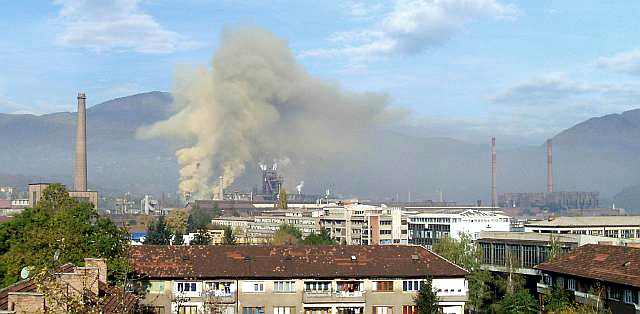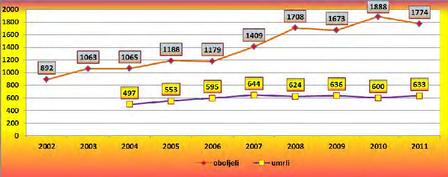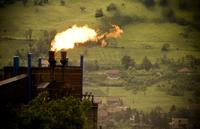
The accident of Sunday, November 4th in Zenica (photo Zenicablog )
In the industrial district of Zenica, Bosnia and Herzegovina, the number of tumours have increased alarmingly over the last ten years. The eyes are on local industries and especially the historic steel factory now privatized. Our report
The citizens of Zenica look at the arrival of autumn and winter with great concern. The town is located in a small, narrow valley – 14 kilometres from Janić to Vranduk, closed between two mountains that are not spaced more than 2 kilometres. As usual from November to February, a toxic cloud forms over the city which traps all the substances rising from the chimneys of steel plants, other factories, and houses.
Because of bizarre historical circumstances, the city and the steel plant have shared the valley for a long time. After the Second World War, the Yugoslav government, with the help of Russians, had plans to build a new steel plant near Doboj, but the Yugoslav-Russian clash in 1948 changed the plans. The Yugoslav government then decided to build the plant in Zenica, on the foundations of the pre-existing Austro-Hungarian complex. The factory was placed in the wrong place from the beginning, in an area beaten by the winds in a way that pollution is blown towards the city.
Therefore, since the second half of the twentieth century, the workplace and the houses have been inextricably joined under a poisonous hood. The population becomes painfully aware of this when winter mists, pregnant with all poisons, make the air so thick and heavy that it is not breathed, but rather swallowed.
Increasing cancer rates
In recent years, doctors and environmental activists have strived to inform the public of the increase of malignant diseases in the territory of Zenica and the entire Zenica-Doboj canton. A 2011 report on the population's health, conducted by the Cantonal Institute for Public Health, reveals alarming statistics.
In the period between 2002 and 2011, tumours have become the second leading cause of death among residents with a striking 20%. According to the report, the number of cancer patients increased from 892 persons in 2002 to 1,888 in 2010 and 1,774 in 2011. If the number of patients had increased from 1063 to 1065 from 2003 to 2004, from 2004 onwards it has increased by the hundreds each year, and especially from 2007 onwards, i.e. since the full production of steel was resumed by reactivating the old plants that had been turned off at the beginning of the war in 1992.
The privatization
The plant was sold twice, but the protection of the environment has never been set as a priority. First, 50% ownership was sold to Kuwait's investment agency, but its announced investments for renewal of production remained such. Then, the Kuwaitis sold their share to the Indo-British company of Lakshmi Nivas Mittal, one of the richest people in the world, who built most of his business empire by buying former socialist steel factories from transition governments that would sell them at any condition, as long as someone could rid them of the workers.
So, Mittal bought the Zenica plant and promised to invest about 80 million dollars – an entirely feasible effort for someone who paid around 60 million dollars for his daughter's wedding and twice as much for a new house in London. Immediately after the acquisition, Mittal announced the New York Stock Exchange that the deal had earned him 80 million dollars.
After the Kuwaitis' final withdrawal, Mittal became the majority owner of the plant, with the local government maintaining a symbolic share.
The ownership transfer contract did not include any obligation to invest in environmental protection. In fact, the new owner was even allowed to reactivate the old plants. Citizens and environmentalists believe the very activation of these old plants such as Koksara (dedicated to the production of metallurgical coke) was the main cause of increased pollution. ArcelorMittal Zenica prefers to highlight the large investments made in the modernization of production and gradual recovery from pollution.
Politicians, environmentalists, and doctors
Politicians, environmentalists, and doctors have different opinions on the possible causes of increasing cancer cases in Zenica. Sretko Radišić, of the Social Democrats (SDP), president of the cantonal assembly, questioned on the possible influence of steel pollution on the deterioration of people's health, says that people tend to see environmental accidents everywhere: "We need to enforce rules and ensure employers' compliance, but also to keep the 3,000 jobs at the steel".
Dr. Suad Sivić, director of the Institute for Public Health of the Zenica-Doboj Canton, told the Sarajevo weekly Dani he believes that Mittal is not the main culprit: "I believe the period of activity of Mittal has been too short to say it caused the increased number of cancers, though it certainly contributes. But Mittal is not the main culprit, which could instead be the country's socio-economic situation". One possible explanation, he adds, could be the improvement in the healthcare system: "The population's increasing awareness may be the cause of the discovery of a larger number of diseases. People go to the doctor and request examinations more often, so we discover more diseases than in the past. But it could also be a real trend, because of all we went through during the war and today's bad living conditions".
Environmentalist Hasan Kreho, however, has been collecting data on the increase in cancers in Zenica-Doboj for years. As an engineer, he has always been convinced that restarting the full production of steel had an effect on the population's health. In 2008, he got the first data from a source (which remains anonymous) who shared his concern for the spread of cancerous diseases in Zenica. Kreho believes that the main cause is that "since 2004, industrial plants were restarted without investing in protecting people's health from harmful emissions of pollutants".
"I think the government wanted to begin production at all costs, for political as well as personal motives and regardless of the consequences on people's health. We know which matters in the technological processes of steel production can cause cancerous diseases. Unannounced inspections should check the internal measurements that all polluting industries would be required to comply with. But without a change in the policy of the federal government, which holds an 8% share in the property of the plant, and the application of the law that regulates the behaviour of polluters, nothing will improve in Zenica". Kreho urges "the Government of the BiH Federation to face the truth and make sure that citizens of Zenica do the same".
Alarming data on the state of citizens' health
Another cause for concern lies in the high mortality rate and speed of cancer patients. According to the report by the Cantonal Institute of Public Health, 50 percent of patients died within a year: "The highest rate of deaths from malignant disease is in Breza, followed by Zenica and Visoko". Obviously, the absolute number of patients and deaths is higher in Zenica, but the ratio between the number of patients and the total number of residents creates confusion and clashes between analysts, doctors, ecologists, and activists.
The report says that 1,012 new patients were officially recorded in 2011. This figure includes 739 new patients and others that had not been registered. This is definitely not the total number of new patients, since registration comes after a given period from the diagnosis. 680 patients were recorded with serious malignant diseases (excluding skin cancer) and 739 with cases of skin cancer. Demographically, men (61.03%) outnumbered women (38.97%) and tumours showed a higher recurrence among people over 65 years old.
The most frequent cancers include those of the trachea, bronchus, and lung (159), with men reporting a recurrence four times higher than women; colo-rectal, breast, female genitals, and prostate cancers follow. Men are mostly affected by cancers of the trachea, bronchus and lung, colon, prostate, and stomach; women by tumours of genitals, breast, trachea, bronchi and lungs, and colon.
"Among fatal cancers in 2011, the most frequent affected lungs and bronchi, stomach and large intestine, and liver. A high number of preventable and curable cancers resulted in the death of the patient (large intestine, breast, stomach, female genitals...). Among men, the leading cause of death was lung cancer, followed by the tumour in the stomach and prostate, liver, and brain, while the most common causes of death for women were breast, lung, and liver cancer", emphasizes the Cantonal Institute for Public Health.
Tumours are now a fact
Minister of Health Senka Balorda recently warned that the time has come to recognize that malignant diseases are increasing in the Canton of Zenica-Doboj. It speaks for itself - says the minister - that lung cancer is the first malignant disease in Zenica and Kakanj, traditional industrial districts of this territory.
Surgeon Harun Drljević, cantonal deputy and Eko forum activist, has warned for years about the relationship between air pollution and increased cancers. Earlier this year Drljević had already made it clear to journalists from the newspaper Oslobođenje: "I recently heard scary data, and namely about an increase of patients with lung cancer. There is no need for special evidence, proof was already provided by the World Health Organization Office in Copenhagen about the carcinogenicity of some pollutants that are released into the air and various substances such as benzene, benzopyrene, cadmium, and lead. It is not a theory, it is a postulate".
He continues: "With prolonged exposure to these pollutants, as is the case in Zenica, an increase is normal in the number of cancer of various organs, depending on the specificities of pollutants. Namely, benzene causes problems at lungs and the urinary tract and interacts with human DNA, thus coming into contact with the foetus. Cadmium causes lung problems, lead damages the central nervous system, kidneys, liver...There is no need to provide special evidence and say that we are going to see an increase in the number of malignant diseases in the long term because of the phenomenon of sedimentation. We already do".










